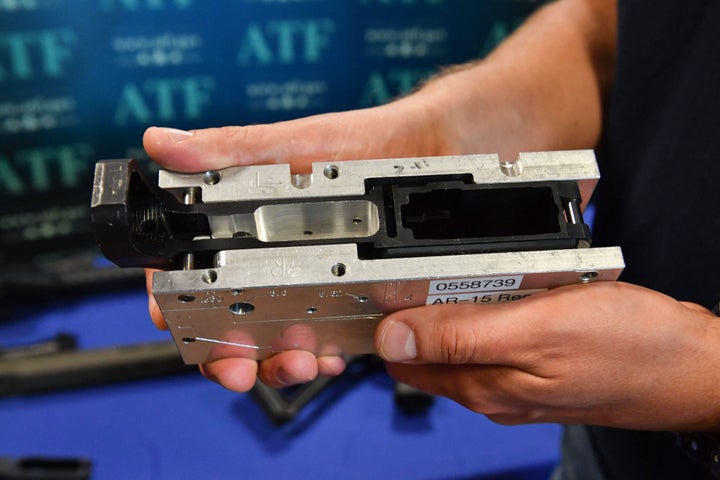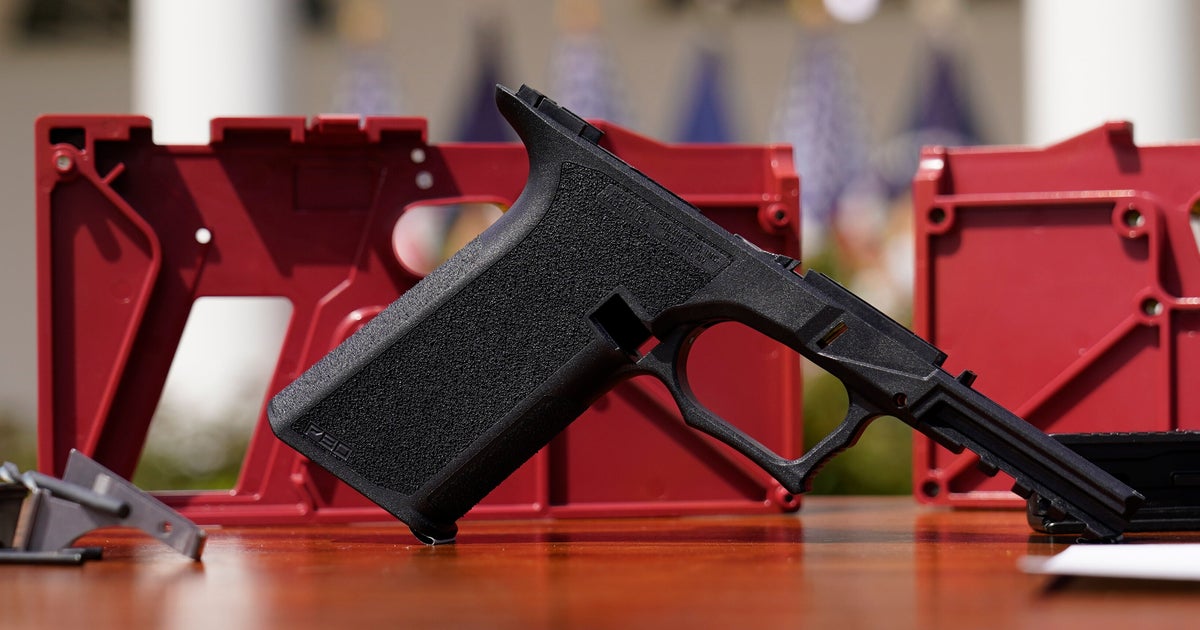The U.S. Supreme Court on Tuesday will hear oral arguments in Garland v. VanDerStok, a case that promises to settle the question of whether weapon parts kits for “ghost guns” require the same regulation as complete firearms bought and sold at gun stores. The case hinges on a key question: Is a bundle of parts that can be readily assembled into a working firearm the same thing as a gun?
As nine of the most powerful legal minds prepared to consider whether ghost guns qualify as firearms, Chris Harris thought of someone who may already have an answer: the Supreme Court’s police force.
“I noticed on the link that guns are prohibited on tours (makes sense),” the vice president of communications for Giffords Law Center, a major gun law reform group, wrote in an email to Supreme Court Police. “Quick question ― Does that prohibition on firearms apply to unfinished frames similar to the one linked below even though it is incapable of firing in its current state?” He then included a link to an incomplete Glock-style pistol frame that might be used to assemble a ghost gun.
“Correct, you cannot bring ANY weapon of ANY kind into the Supreme Court building or grounds,” the security team responded in a message shared with HuffPost.
For gun reform advocates, the issue is as obvious as it is for the Supreme Court Police: A gun is a gun.
“These emails reveal that the Supreme Court itself considers ghost guns to be guns — because they are,” Harris wrote in an email to HuffPost. “Justices must apply that same common sense to the law and allow the [Bureau of Alcohol, Tobacco, Firearms and Explosives (ATF)] to do the job it was created to do.”
The case raises similar disputes over definitions that doomed a rule implemented during the Trump administration to ban bump stocks, the devices that accelerate semiautomatic fire, after they were used in the October 2017 Route 91 Harvest Music Festival shooting in Las Vegas, which left 60 people dead and more than 400 injured. The Supreme Court contended that the ATF overstepped its bounds by redefining the devices as “machine guns.”
Tuesday’s case does not raise Second Amendment issues. Instead, two individuals, a nonprofit group and several businesses have challenged the Justice Department’s authority to alter the definition of “firearm,” as well as the definitions of “frame” and “receiver,” so that home-assembled guns count as firearms under federal law. Because they contain the firing mechanisms, the pistol frames and long gun receivers are subjected to the same regulations as complete firearms, while other parts, such as stocks, trigger groups and magazines, can be bought and sold more freely.
The government considers frames (for pistols) and receivers (for rifles) the defining parts of a firearm, requiring them to bear serial numbers and subjecting them to the same regulation as as complete guns. Frames and receivers play similar roles in a firearm, housing the firing mechanism.
Americans have long had the ability to make firearms for private use at home. But in recent years, with the explosion of internet commerce, easier accessibility to high-quality machining and the proliferation of 3D printing, user-assembled guns have become a growing challenge for law enforcement.
Unlike complete guns sold by federally licensed firearms dealers, producers of ghost guns did not have to have a serial number on their products or become federal firearms licensees (FFLs) to sell them at commercial scale until two years ago. Without the FFL requirement, customers were free to purchase ghost gun kits without passing a background check and to order them online — though several states restrict their sale.

ROBYN BECK/AFP via Getty Images
Those features make them attractive to criminals. Though ghost guns make up a tiny segment of the U.S. firearms market, they have become far more common at arrests and crime scenes. The ATF submitted 1,600 ghost guns for tracing in 2017, according to court filings. That figure shot up to 19,000 by 2021.
Without serial numbers, the ATF traced fewer than 1% of more than 45,000 ghost guns to their original purchasers from 2016 to 2021.
To confront that problem, the ATF, an agency within the Department of Justice, adopted a rule in 2022 clarifying that the term “firearm” applied to weapon kits that could be readily assembled into a working gun. It made the same clarification to the terms “frame” and “receiver.” Weapon kits often include frames and receivers that require a small amount of tooling to make them operable, such as milling down bits of plastic with a grinding tool.
“Before the ATF acted, literally anyone could obtain an untraceable ghost gun with no background check,” Harris wrote in an email. “That should horrify anyone who is concerned about gun violence, crime, or their family’s safety.”
That change prompted a lawsuit from Jennifer VanDerStok and Michael Andren, two Texans who wanted to buy weapon kits despite the new rule. The Firearms Policy Coalition, a nonprofit that has been involved in numerous lawsuits to maintain or expand Second Amendment rights, is also a plaintiff in the lawsuit, as well as several companies that produce the weapon kits.
The lawsuit contends that Congress had the chance to define those terms along the lines proposed by the ATF back when it passed the Gun Control Act of 1968 (GCA) but didn’t. It notes that Tactical Machining LLC, a Florida company that is part of the lawsuit, submitted its weapon kits to the ATF for classification before the new rule; the ATF found that the kits did not constitute firearms.
“The Final Rule defies the plain language of the GCA and longstanding agency interpretation suggesting that the items at issue here, sometimes colloquially referred to as receiver blanks, unfinished frames or receivers, or 80% frames or receivers, are not firearms,” the complaint says.
The U.S. Court of Appeals for the 5th Circuit ultimately sided with the plaintiffs, invalidating the rule last year.
The Biden administration contends that the 5th Circuit’s ruling contradicts the spirit of the law and the ATF’s longstanding interpretation. The ATF has long held that firearms, frames and receivers retain their classification even when disassembled.
Congress passed the Gun Control Act of 1968 and imposed serialization and background checks largely to confront the problem of criminals, minors and other prohibited buyers from obtaining weapons by mail — challenges that have resurfaced with ghost guns.
Upholding the 5th Circuit’s ruling, government lawyers argue, would make it easy to evade decades-old laws designed to keep guns out of the hands of criminals.
Support Free Journalism
Support HuffPost
Already contributed? Log in to hide these messages.
“If a State placed a tax on the sale of tables, chairs, couches, and bookshelves, IKEA could not avoid paying by insisting that it does not sell any of those items and instead sells ‘furniture parts kits’ that must be assembled by the purchaser,” Justice Department attorneys wrote in a court filing. “So too with guns: A company in the business of selling kits that can be assembled into working firearms in minutes — and that are designed, marketed, and used for that express purpose — is in the business of selling firearms.”
The conservative-majority Supreme Court vastly expanded Second Amendment rights in its New York State Rifle and Pistol Assn. v. Bruen ruling two years ago.
That decision, penned by Justice Clarence Thomas, laid out a new standard for judging the constitutionality of laws designed to restrict gun rights in the name of public safety. Courts can no longer cite the need to protect the public to restrict the right to bear arms. Instead, judges must assess only whether a challenged law stems from a tradition of firearm regulation dating back to some time between the signing of the Bill of Rights in 1791 and the end of the Civil War in 1865.
The decision set off a series of Second Amendment challenges to broaden gun rights that are still playing out in lower courts.
Support Free Journalism
Support HuffPost
Already contributed? Log in to hide these messages.

